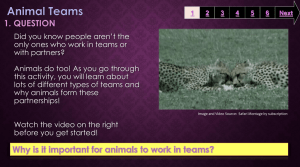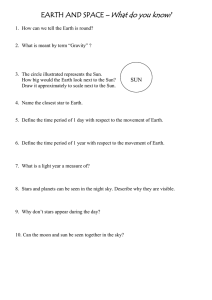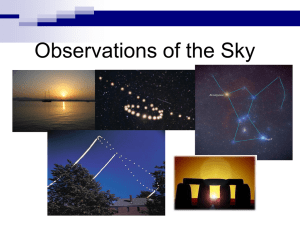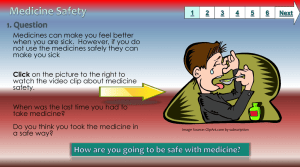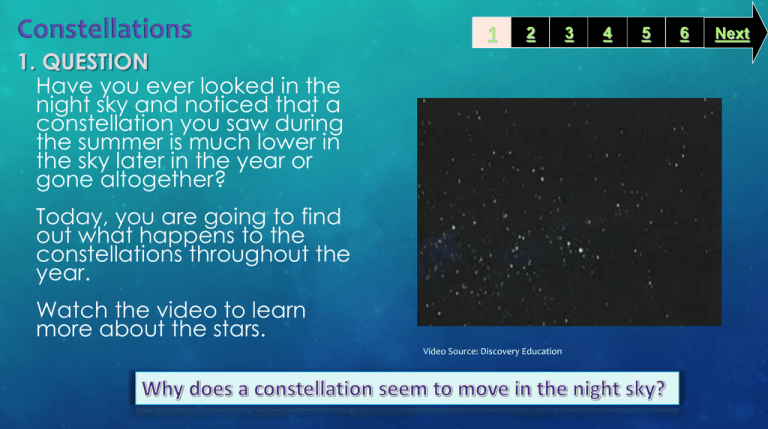
1
2
1. QUESTION
Have you ever looked in the
night sky and noticed that a
constellation you saw during
the summer is much lower in
the sky later in the year or
gone altogether?
Today, you are going to find
out what happens to the
constellations throughout the
year.
Watch the video to learn
more about the stars.
Video Source: Discovery Education
3
4
5
6
Next
2. INFORMATION SOURCES
1
2
3
4
5
6
Watch the two videos below to find out why constellations
appear higher or lower in the sky.
The North Star
Stars and Seasons
Video Sources: Discovery Education
Video Source: Discovery Education
Next
3. STUDENT ACTIVITY
1
After watching the videos on slide 2,
click on the Stars and Seasons worksheet
and answer the 3 questions.
This will help you complete your assessment
activity.
Image Source: Clipart.com by subscription
2
3
4
5
6
Next
4. ASSESSMENT ACTIVITY
1
2
3
4
5
6
Your best friend doesn’t understand why
the constellations seem to move around
the night sky.
Create a Voki to explain to your best
friend why the constellations seem to
move.
Use this script to help you plan out what
to say.
Use this rubric to help you finish your
work.
Click me to go to Voki!
Image Source: voki.com
Next
5. ENRICHMENT ACTIVITIES
1
2
3
Learn more about the life cycle of a star!
4
5
6
Next
Make your own
constellation!
Read on TumbleBooks!
See your librarian for
login information.
Video Source: Discovery Education by subscription
Image Source: Tumblebooks by
subscription
Image Source: pbs.org
6. TEACHER SUPPORT MATERIALS
BCPS Curriculum / Maryland State Curriculum
Grade 1: Science: Space Unit
Next Generation Science Standards
•
ESS1.A: The Universe and its Stars:
Patterns of the motion of the sun, moon, and stars in the sky can be observed, described, and predicted. (1-ESS1-1)
1
2
3
4
5
6
Time Frame:
Two to Three 50 minute periods with Grade 1 accelerated students.
Differentiation:
•
Students can either use the Voki script or they can create their
own script.
•
Common Core State Standards
Students can work in partners or small groups to complete the
assignment.
Reading: 1. Read closely to determine what the text says explicitly and to make logical inferences from it; cite specific textual
evidence when writing or speaking to support conclusions drawn from the text.
Learning Styles:
Writing: 7. Conduct short as well as more sustained research projects based on focused questions, demonstrating
understanding of the subject under investigation.
• Visual, auditory, kinesthetic, tactile, active, reflective, global,
analytical
Standards for the 21st Century Learner
1.1.6 Read, view, and listen for information presented in any format (e.g. textual, visual, media, digital) in order to make
inferences and gather meaning.
2.1.3 Use strategies to draw conclusions from information and apply knowledge to curricular areas, real-world situations,
and further investigations.
ISTE NETS - National Educational Technology Standards for Students
3. Research and Information Fluency: Students apply digital tools to gather, evaluate, and use information.
b. Locate, organize, analyze, evaluate, synthesize, and ethically use information from a variety of sources and media.
4. Critical Thinking, Problem Solving, and Decision Making: Students use critical thinking skills to plan and conduct research,
manage projects, solve problems, and make informed decisions using appropriate digital tools and resources. c. Collect
and analyze data to identify solutions and/or make informed decisions.
Notes to the teacher:
• Collaborate with your school’s Library Media Specialist to
implement this research project.
• This Slam Dunk research project should be used in conjunction
with the Grade 1 science Space Unit.
• If you have any problems with the links, contact your Library
Media Specialist.
• Keep a copy of logins and passwords handy in case students are
having difficulties.
•
Students will have to search for Eight Days Gone in TumbleBooks.
Last updated: July 2014
Created by Marlena Aumen, Library Media Specialist Intern
BCPS Slam Dunk Research Model, Copyright 2013, Baltimore County Public Schools, MD, all rights reserved. The models may be used for educational, non-profit school use only.
All other uses, transmissions, and duplications are prohibited unless permission is granted expressly. This lesson is based on Jamie McKenzie’s Slam Dunk Lesson module.

